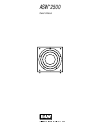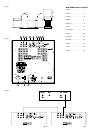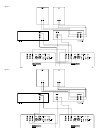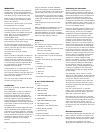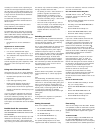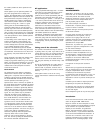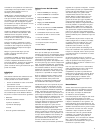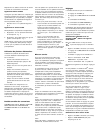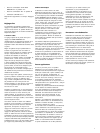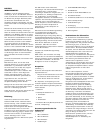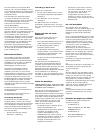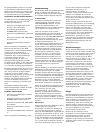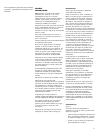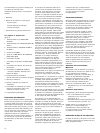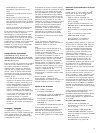
4
the relative positions of all the speakers in the
installation.
Set the system up in the preferred position and
play some programme with a steady bass
content. The optimum setting for the LOW-PASS
FREQUENCY depends on several variables; the
bass performance and power handling of the
satellite speakers, the number of subwoofers
used and their position relative to the satellite
speakers. The range 80 – 90Hz is a good
starting point for the LOW-PASS frequency.
Unless two subwoofers are used to preserve
separate right and left channel information and
are sited close to the relevant satellite speakers,
using a higher cut-off frequency may compromise
the stereo image and should only be considered
if the bass performance of the satellite speakers
is particularly limited.
At each setting of the cut-off frequency, listen
with the phase switch in both positions. The
correct one is that which gives the fullest bass
and that will depend on the bass characteristics
of your satellite speakers and the relative
distances of the subwoofer(s) and the satellite
speakers to the listeners. When using more than
one subwoofer, ensure that each one has its cut-
off frequency and phase switch set the same
way.
Set the loudness of the subwoofer relative to the
satellite systems to your liking. Use a wide
variety of programme material to get an average
setting. One that sounds impressive on one piece
may sound overpowering on another. Listen at
realistic levels as the perception of balance
varies with sound level.
Home theatre
The situation with home theatre is somewhat
different from 2-channel audio. The subwoofer
(LFE) signal is a separate channel rather than an
extension of the signal to the satellite speakers.
The LOW-PASS filter is switched out, because the
decoder provides all the filtering for any
speakers set to “small”. However, the position of
the phase switch must still be assessed. Normally
the phase will be set to 0˚, but if the subwoofer
is positioned at a distance significantly different
from the other speakers, or the power amplifier
driving the other speakers happens to invert the
signal, the 180˚ position may be preferable.
Listen with the switch in both positions and
choose the one that gives the fullest sound. If
there is little difference, leave the switch at 0˚.
Decoders normally have a calibrated noise
signal that can be used to set the relative levels
of all the speakers, making the task somewhat
more straightforward than for 2-channel audio.
However, do not be afraid to alter the settings to
your personal preference. It is all too easy to get
carried away with the capabilities of the
subwoofer, especially with some special low-
frequency effects. Often a more realistic
portrayal, and one more satisfying in the long
term, is to be had by setting the subwoofer level
lower that the standard calibration level.
All applications
If you get problems with lumpy bass – if certain
bass notes are exaggerated more than others –
then you probably have a room interface
problem and it is worth experimenting with the
placement of the subwoofer. What may seem
like small changes in position – 15cm (6in) or so
– can have a profound effect on the sound. Try
raising the subwoofer clear of the floor as well
as lateral movement. The use of multiple
subwoofers can smooth the effects of room
resonances, as each subwoofer will tend to
excite resonances at different frequencies. If you
alter the relative distances from the subwoofer(s)
and satellite speakers to the listeners
appreciably, reassess the phase switch setting.
You should also check the level setting of the
subwoofer (using either the decoder output levels
or the volume control on the subwoofer amplifier
as appropriate), but only after setting the phase
correctly.
Taking care of the subwoofer
The cabinet of the subwoofer may be cleaned
by dusting with a dry cloth. If you wish to use an
aerosol cleaning spray, do not spray directly on
the cabinet; spray onto the cloth. Remove the
grille first so that the cloth does not become
stained, but be careful not to disturb the drive
unit. The grille itself may be cleaned using a soft
brush.
Do not use the subwoofer as a table. When in
use, objects left on top of the subwoofer are
liable to rattle. In particular, avoid the risk of
liquids being spilled (eg from drinks or vases of
flowers).
If the system is taken out of use for a long
period, disconnect the subwoofer from the power
supply.
FRANÇAIS
AVERTISSEMENTS:
ATTENTION: les versions 120V de ce produit
sont livrées avec un cordon d’alimentation avec
connecteur polarisé. Pour éviter les chocs
électriques, introduisez la lame la plus large de
la fiche dans la borne correspondante de la
prise et poussez jusqu’au fond.
Pour éviter tout risque d’incendie ou
d’électrocution, n’exposez jamais cet appareil à
la pluie ou même a l’humidité.
Observez tout signe anormal pouvant provenir
du subwoofer lui-même.
N’ouvrez jamais l’enceinte et ne sortez pas
l’amplificateur de son logement ; vous n’y
trouverez aucun réglage utile. En cas de
problème renseignez-vous, préalablement à toute
intervention, auprès d’un véritable revendeur
spécialiste de la marque B&W.
Assurez-vous, en premier lieu, que la tension
indiquée sur l’appareil correspond bien a celle
de votre réseau électrique.
Les fusibles d’alimentation se trouvent sur le
panneau du module d’amplification. En cas
de remplacement, n’utilisez jamais de fusibles
d’un type différent ; vérifiez que les valeurs
indiquées sur les nouveaux fusibles sont
parfaitement identiques à celles qui figurent sur
les modèles d’origine.
Cet appareil ne doit pas être raccordé à
la terre.
Assurez-vous que l’appareil est correctement
aéré. N’empêchez-pas l’air de circuler autour de
la plaque d’amplification située à l’arrière.
N’obstruez-pas les ouvertures du panneau.
N’encastrez-pas cette enceinte dans un rack, une
étagère, une niche ou un meuble si le volume
disponible à l’arrière ne peut être ventilé par l’air
ambiant.
Contrôlez que les câbles ne risquent pas d’être
transpercés par les pointes de découplage.
Ne déplacez pas l’appareil en le faisant glisser
sur ses pointes. Vous risquez de les arracher ou
de créer des dégats.
Prenez simplement garde de ne pas vous piquer.
Introduction
Nous vous remercions d’avoir choisi l’enceinte
active de subgrave B&W ASW™2500.
Depuis la création de notre entreprise en 1966,
la base invariable de notre philosophie a toujours
été la recherche de la perfection absolue.
Inspirée par son fondateur, le regretté John
Bowers, cette extraordinaire aventure qu’est la
quête de l’absolu, n’a pas seulement débouché
sur de très lourds investissements consacrés à la
recherche et à l’innovation, mais aussi sur une
profonde connaissance de la musique et des
spécificités du son cinématographique. Cette



